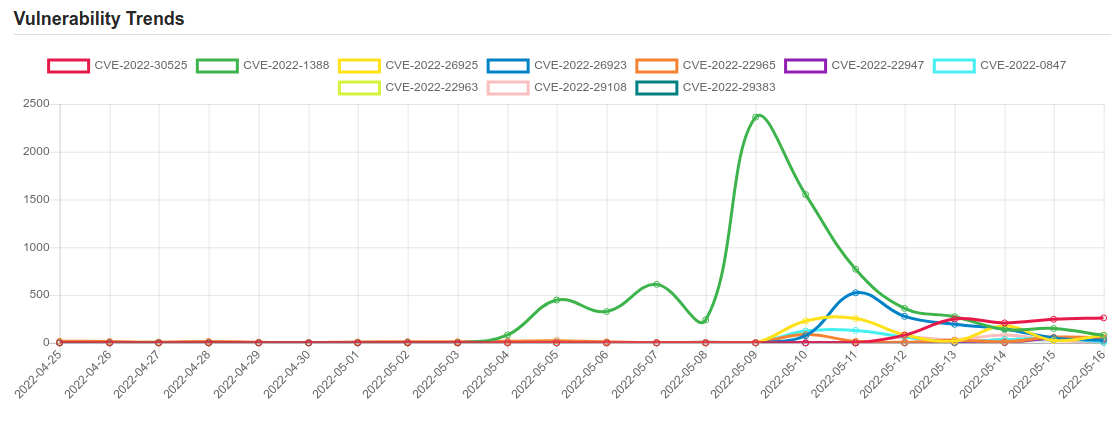Daily Vulnerability Trends: Tue May 17 2022

| CVE NAME | CVE Description |
| CVE-2022-25762 | If a web application sends a WebSocket message concurrently with the WebSocket connection closing when running on Apache Tomcat 8.5.0 to 8.5.75 or Apache Tomcat 9.0.0.M1 to 9.0.20, it is possible that the application will continue to use the socket after it has been closed. The error handling triggered in this case could cause the a pooled object to be placed in the pool twice. This could result in subsequent connections using the same object concurrently which could result in data being returned to the wrong use and/or other errors. |
| CVE-2022-0543 | It was discovered, that redis, a persistent key-value database, due to a packaging issue, is prone to a (Debian-specific) Lua sandbox escape, which could result in remote code execution. |
| CVE-2022-22675 | No description provided |
| CVE-2022-22005 | Microsoft SharePoint Server Remote Code Execution Vulnerability. |
| CVE-2022-30779 | Laravel 9.1.8, when processing attacker-controlled data for deserialization, allows Remote Code Execution via an unserialize pop chain in __destruct in GuzzleHttp\Cookie\FileCookieJar.php. |
| CVE-2022-29586 | Konica Minolta bizhub MFP devices before 2022-04-14 allow a Sandbox Escape. An attacker must attach a keyboard to a USB port, press F12, and then escape from the kiosk mode. |
| CVE-2022-30525 | A OS command injection vulnerability in the CGI program of Zyxel USG FLEX 100(W) firmware versions 5.00 through 5.21 Patch 1, USG FLEX 200 firmware versions 5.00 through 5.21 Patch 1, USG FLEX 500 firmware versions 5.00 through 5.21 Patch 1, USG FLEX 700 firmware versions 5.00 through 5.21 Patch 1, USG FLEX 50(W) firmware versions 5.10 through 5.21 Patch 1, USG20(W)-VPN firmware versions 5.10 through 5.21 Patch 1, ATP series firmware versions 5.10 through 5.21 Patch 1, VPN series firmware versions 4.60 through 5.21 Patch 1, which could allow an attacker to modify specific files and then execute some OS commands on a vulnerable device. |
| CVE-2022-1388 | On F5 BIG-IP 16.1.x versions prior to 16.1.2.2, 15.1.x versions prior to 15.1.5.1, 14.1.x versions prior to 14.1.4.6, 13.1.x versions prior to 13.1.5, and all 12.1.x and 11.6.x versions, undisclosed requests may bypass iControl REST authentication. Note: Software versions which have reached End of Technical Support (EoTS) are not evaluated |
| CVE-2022-26925 | Windows LSA Spoofing Vulnerability. |
| CVE-2022-26923 | Active Directory Domain Services Elevation of Privilege Vulnerability. |
| CVE-2022-22965 | A Spring MVC or Spring WebFlux application running on JDK 9+ may be vulnerable to remote code execution (RCE) via data binding. The specific exploit requires the application to run on Tomcat as a WAR deployment. If the application is deployed as a Spring Boot executable jar, i.e. the default, it is not vulnerable to the exploit. However, the nature of the vulnerability is more general, and there may be other ways to exploit it. |
| CVE-2022-22947 | In spring cloud gateway versions prior to 3.1.1+ and 3.0.7+ , applications are vulnerable to a code injection attack when the Gateway Actuator endpoint is enabled, exposed and unsecured. A remote attacker could make a maliciously crafted request that could allow arbitrary remote execution on the remote host. |
| CVE-2022-0847 | A flaw was found in the way the “flags” member of the new pipe buffer structure was lacking proper initialization in copy_page_to_iter_pipe and push_pipe functions in the Linux kernel and could thus contain stale values. An unprivileged local user could use this flaw to write to pages in the page cache backed by read only files and as such escalate their privileges on the system. |
| CVE-2022-22963 | In Spring Cloud Function versions 3.1.6, 3.2.2 and older unsupported versions, when using routing functionality it is possible for a user to provide a specially crafted SpEL as a routing-expression that may result in remote code execution and access to local resources. |
| CVE-2022-29108 | Microsoft SharePoint Server Remote Code Execution Vulnerability. |
| CVE-2022-29383 | NETGEAR ProSafe SSL VPN firmware FVS336Gv2 and FVS336Gv3 was discovered to contain a SQL injection vulnerability via USERDBDomains.Domainname at cgi-bin/platform.cgi. |
| CVE-2022-1040 | An authentication bypass vulnerability in the User Portal and Webadmin allows a remote attacker to execute code in Sophos Firewall version v18.5 MR3 and older. |
| CVE-2022-28346 | An issue was discovered in Django 2.2 before 2.2.28, 3.2 before 3.2.13, and 4.0 before 4.0.4. QuerySet.annotate(), aggregate(), and extra() methods are subject to SQL injection in column aliases via a crafted dictionary (with dictionary expansion) as the passed **kwargs. |
| CVE-2019-0567 | A remote code execution vulnerability exists in the way that the Chakra scripting engine handles objects in memory in Microsoft Edge, aka “Chakra Scripting Engine Memory Corruption Vulnerability.” This affects Microsoft Edge, ChakraCore. This CVE ID is unique from CVE-2019-0539, CVE-2019-0568. |
| CVE-2022-30778 | Laravel 9.1.8, when processing attacker-controlled data for deserialization, allows Remote Code Execution via an unserialize pop chain in __destruct in Illuminate\Broadcasting\PendingBroadcast.php and dispatch($command) in Illuminate\Bus\QueueingDispatcher.php. |
If you like the site, please consider joining the telegram channel and supporting us on Patreon using the button below.


